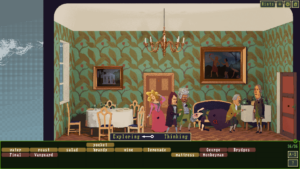A couple months back, a sequel to The Talos Principle dropped quite unexpectedly, nine years after the original. I know I’m not the only one to be taken by surprise. I picked it up in the holiday sales, and have now 100%ed it. This is not nearly as difficult as it was in Talos 1. The main-line puzzles strike me as generally simpler than in the original, each based entirely around a single trick.
It manages this mainly by steadily expanding the set of puzzle elements, and it’s a little impressive how many of the new components sound like they’d make the puzzles utterly trivial. Teleporters! Extra bodies for you to control! Portable beam emitters! Universal activators that just switch anything on! But each has an important limitation, usually that it’s in some way bound by line-of-sight rules. This has really always the main factor making the familiar beam puzzles difficult, but it’s dressed up in a bunch of different ways now.
As for the optional harder puzzles, well, they’ve become more systematized. Each of the game’s twelve main puzzle-areas has two optional slightly-harder puzzle-chambers and two “star” challenges chosen from three types: a chase sequence where you pursue some particle effects around the map, a sort of riddle where you’re shown a map or other image and have to figure out what it depicts and what to do with it, and a sort where you have to somehow connect a beam from the puzzle chambers to a target outside them. All three types of star challenge involve searching the lands around the puzzle chambers, which can take a while, because the lands are almost unexplorably large this time around. With my stubborn insistence on completion, I might have spent more time running around looking for stuff than solving the real puzzles. Also, the last type, with the beam, is the only one that resembles the boundary-violating star puzzles from Talos 1, and while it plays some neat tricks with the idea, I think it loses a lot by being a set type, where you know more or less what you’re supposed to do. Specifically, it loses the sense of breaking the rules that was a big part of the game’s character, and in my opinion the most memorable thing about it. But I suppose the new stuff is supposed to be more approachable. Like the more actiony bits in an action-adventure, it gives you stuff to do when you’re fatigued from solving puzzles. Except I don’t think I ever was.
Even though the core puzzle-solving isn’t greatly changed from the original, I appreciate that the designers decided not to simply rehash the plot or setting. Where Talos 1 was explicitly set in a simulated environment, Talos 2 is supposed to be set in the physical world, where the robots awakened by the events of the previous game have formed a society. Like DROD: The City Beneath, there are biggish sequences where you just explore a puzzleless home town with NPCs wandering around. Some of the NPCs accompany you on your mission. You might think that they could help you in the puzzle chambers, and thereby enable complicated multiple-person puzzles like in Portal 2 or The Lost Vikings (something hinted at by the way NPCs help you along in the final few puzzles in Talos 1), but even when the game does provide puzzles of that sort, it doesn’t use your companions for them. (My uninformed speculation is that the designers initially provided companions with the intent that they be used in these puzzles, but changed their minds to justify line-of-sight rules.)
And, being set in the physical world, the existence of puzzle chambers suspiciously similar to the ones from the simulation is something of a mystery. Who made them, and why, and most particularly, how? These are the questions that drive the plot, and they’re all answered satisfactorily by the end. The ultimate revelations reminded me of Obsidian , one of my favorite 1990s Mystlikes, but with a stronger sense of motivation — I suppose making every single character an AI helps prevent lazy “rogue AI goes mad” plotting. And at any rate, the thing that sets it apart from Talos 1 isn’t the resolution, but the fact that there’s a mystery about it at all.
Mostly, though, the feel of the thing is different from Talos 1 because it’s not dominated by a sense of loss and decay. (Possibly as a reaction to this, it also has less of the gratuitous silly stuff, or maybe the larger spaces just lessen its density.) The robots — who call themselves “humans”, on the basis that they’re the progeny of and successors to the original biological ones — are building a home for themselves, a society, a future. And in the background of the story is an endless debate over what kind of future they want to build.
This takes the place of the “What is human?” philosophizing of the first game. Even Straton of Stageira, the fictional Greek philosopher who formulated the Talos principle, is dragooned into weighing in, extending his principle to apply not just to people but to the polis. And look, the philosophy in Talos 1 was pretty bloodless and abstract, especially compared to the global tragedy underneath it; it’s fundamentally a definitional argument, and thus only of interest because of how those definitions affect the decisions of an arbitrary authority (which is why the real story there is one of obedience vs rebellion). The philosopher-robots of Talos 2 are debating things that directly affect public policy, and thus their lives. But it still feels a little airy. Robot society is small and relatively new, and doesn’t have the complications of history, of biology, of ethnicity and nation and race. The divisions are shallow, based entirely on personal opinions, without the weight of tradition (despite the efforts of some robots to revere their creators). It’s an internet rationalist’s paradise.
Perhaps that’s why it took me so long to notice how political the game gets. The main point of contention is unfettered growth and expansion vs regulation, limited population, and deference to the balance of nature — with no real moderate stance presented. The player can take either side, affecting the ending, and, having looked at all the ending cinematics on Youtube, I’d say it does a pretty good job of at least giving the players inclined towards one side or the other something that they’d find satisfying. But on the way there, it seriously favors the unfettered expansion. Limitationists are portrayed as fools, hypocrites, or hypocrites pretending to be fools, with just one exception, and even he doesn’t make a satisfying case for his position, as if the writer didn’t really understand it. And these are the people who are in charge and culturally dominant at the start of the game, resulting in citywide malaise, a breaking of the human spirit, an obsession with the past, and not just an inability to innovate but an inability to even adequately maintain the existing infrastructure they depend on. Meanwhile, the people who walked away from that society create incredible things. This is not far removed from the plot of Atlas Shrugged. It’s not that the reaction it’s trying to provoke is wrong, exactly, given its context. But I’m instinctively wary of narrative rhetoric that’s historically been used mainly in support of loathsome and antisocial positions, and I’m a little taken aback at how little recognition this aspect of the game has gotten from other commentators.
But then again, worse can be said of a very large proportion of all games. Probably the majority of the titles on my Stack implicitly endorse war and/or colonialism. Heck, a lot of them endorse monarchism. And I just kind of accept that, because they don’t leave room for any other points of view. At least Talos 2 acknowledges that people might disagree.
 3 Comments
3 Comments
